 Weird Stuff
Weird Stuff  Weird Stuff
Weird Stuff  Mysteries
Mysteries 10 Tragic Disappearances and Deaths in Joshua Tree National Park
 History
History 10 Ways Childhood Really Sucked in the Old West
 Music
Music 10 Name Origins of Famous Bands from the 1990s
 Religion
Religion 10 Biggest Turnarounds by the Catholic Church
 Weird Stuff
Weird Stuff 10 Unbelievable Times Laws Had Unintended Consequences
 Humans
Humans Ten Historic Women Who Deserve Way More Credit Than They Got
 Movies and TV
Movies and TV 10 Films That Spawned Major Lawsuits
 History
History Ten Times Towns Were Wiped Off the Face of the Earth
 Creepy
Creepy 10 of the Most Disturbingly Haunted Public Houses in the UK
 Weird Stuff
Weird Stuff 10 Niche Subcultures That Are More Popular Than You Might Think
 Mysteries
Mysteries 10 Tragic Disappearances and Deaths in Joshua Tree National Park
 History
History 10 Ways Childhood Really Sucked in the Old West
Who's Behind Listverse?

Jamie Frater
Head Editor
Jamie founded Listverse due to an insatiable desire to share fascinating, obscure, and bizarre facts. He has been a guest speaker on numerous national radio and television stations and is a five time published author.
More About Us Music
Music 10 Name Origins of Famous Bands from the 1990s
 Religion
Religion 10 Biggest Turnarounds by the Catholic Church
 Weird Stuff
Weird Stuff 10 Unbelievable Times Laws Had Unintended Consequences
 Humans
Humans Ten Historic Women Who Deserve Way More Credit Than They Got
 Movies and TV
Movies and TV 10 Films That Spawned Major Lawsuits
 History
History Ten Times Towns Were Wiped Off the Face of the Earth
 Creepy
Creepy 10 of the Most Disturbingly Haunted Public Houses in the UK
10 Ways European Witch Finders Tested Their Victims
From the 15th through the 18th centuries, Europe was a scary place, particularly if you were an elderly woman. Tension between the Catholic Church and the Protestant Church meant that religious terror was rife, bad luck was blamed on Devil worshipers, and the European witch trials claimed the lives of around 200,000 people across Germany, Sweden, France, and Britain.
Witch finders used a range of bizarre methods, often bordering on torture, to entice confessions from the accused or otherwise “prove” their guilt. Would any of these insane tests prove you guilty of witchcraft?
10 Waking The Witch
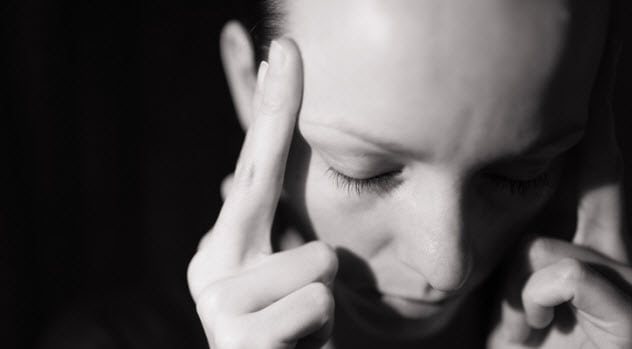
The Italians pioneered a particularly uncomfortable method for testing witches that became very popular in Scotland. We know it now as sleep deprivation. This may sound like something you have suffered yourself if you work a stressful job or have young children. But for accused witches, it was a creatively cruel trial and punishment.
The accused had an iron hoop with four sharp prongs forced into her mouth. It was then attached to the wall behind her, the effect being that she would be in pain and unable to lie down.
The men charged with guarding the witch were also instructed to keep her awake through whatever means they deemed necessary. Usually, after about three days of this, the victim would start to vividly hallucinate. When questioned in this state, the accused would recount fantastical tales of flying, turning into animals, and partaking in satanic rituals.[1]
The witch catchers proclaimed that this was the witch “awakening” within the woman and was undeniable proof of her guilt. Those found guilty of witchcraft in Scotland were usually strangled at the stake and then burned.
9 Touch Test

In 1662, two elderly women in England were subjected to the infamous “touch test.” Their names were Rose Cullender and Amy Denny. They were charged with bewitching two young girls who had been suffering with fits.
The witch hunters believed that someone who was under the influence of sorcery would have an unusual reaction to physical contact with the spellcaster. The suspect would be brought into the room and forced to lay her hands on the person having fits. If the illness ceased, this was seen as proof that the accused was guilty.
In the Cullender and Denny case, it was said that the suffering children held their fists so tightly clenched that even the strongest man in the village could not pry their fingers open. Yet, as soon as they were touched by the accused women, the girls stopped their fits and easily opened their palms.[2]
To test if the girls were lying, the judge had them blindfolded and touched by other members of the court. It was found that they had the same reaction every time someone placed their hands on the girls. So they were faking. Despite this, Cullender and Denny were found guilty and faced execution by hanging.
8 The Rack
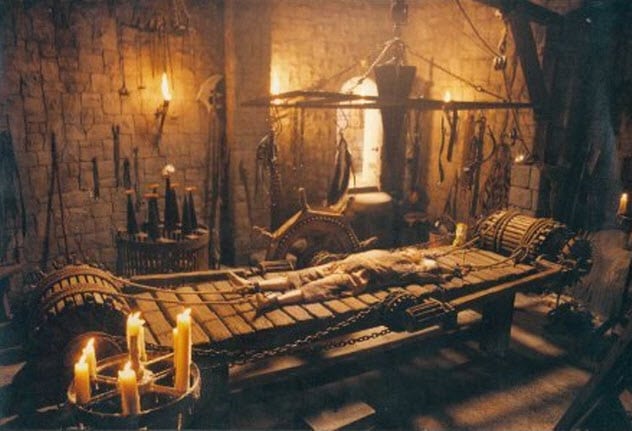
Germany is usually considered to be the country that executed the most witches. During the 1620s, the five-year-long Wurzburg trials are estimated to have killed over 900 people. No one was safe from the Prince Bishop Philipp Adolf von Ehrenberg, including his own nephew, 19 Catholic priests, and some boys. Seven were found guilty of having sexual intercourse with demons before being beheaded or burned at the stake.
The accused were found guilty following confession, and torture was not yet illegal in Central Europe. The Germans had many cruel methods of forcing confessions from their victims, but the most popular was the rack.
It usually consisted of an iron frame with a wooden roller at one or both ends. The unfortunate souls had their hands bound to one roller and their ankles bound to the other. During their interrogations, their torturers would use the rollers to increase the tension on the binds and essentially stretch the accused.[3]
The joints of the victim would eventually be dislocated and then separated entirely while they listened to the sickening popping and snapping of their own bones. Would that be enough to make you plead guilty to witchcraft?
7 Pricking
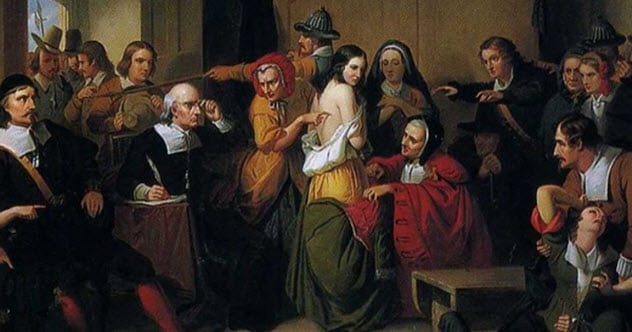
Witch pricking was once considered to be the most accurate way of testing for witchcraft. The accused would be stripped completely naked in front of the court and then shaved from head to toe. The witch pricker (a revered profession) would then seek out the “Devil’s mark” by pricking the victim all over with a thick needle.
It was believed that there would be a spot that did not bleed or cause pain—proof of a contract with the Devil. This was really a form of horrendous sexual abuse. In a society that held modesty in high regard, many women would confess just to end the humiliation.
In Scotland, a witch pricker could expect to make £6 per witch discovered. When you consider that the average daily wage in those days was one shilling, this was a significant amount.
As with most jobs, it was a male profession. But that didn’t stop one woman from becoming one of the most infamous witch prickers of all time. While dressed as a man and calling herself John Dickson, Christian Caddell sentenced as many as 10 witches to death. She was eventually caught and banished to the fever-ridden Barbados. Many people didn’t even survive the voyage.[4]
6 Spotted By Visgossar
 Sweden was unique in its persecution of witches because it relied heavily on the witness testimonies of children (often the offspring of the accused), who were tortured until they provided suitably fantastical tales.
Sweden was unique in its persecution of witches because it relied heavily on the witness testimonies of children (often the offspring of the accused), who were tortured until they provided suitably fantastical tales.
The children would be predominantly questioned about their experiences visiting Blakulla—not hell, but the Devil’s banqueting hall with a peek hole in the floor through which one could observe Hell beneath. Some of the youths would find themselves competing to fabricate the most creative stories, which would ultimately end with the execution of their parents.
The visgossar were young boys who were believed to have the power to spot the invisible Stigma Diaboli (mark of the Devil) on the forehead of the witch. Following a church service, it was common practice for the boys to point at a few women and name them guilty. These poor folks were often executed just days later.[5]
The boys were paid per witch identified, and this meant that many homeless orphans and beggars would come forward claiming to be visgossar as a way to make easy money. Of course, the profession came with its own dangers. On several occasions, vigossar were found beaten to death by the families of those they accused.
5 Ducking Stool
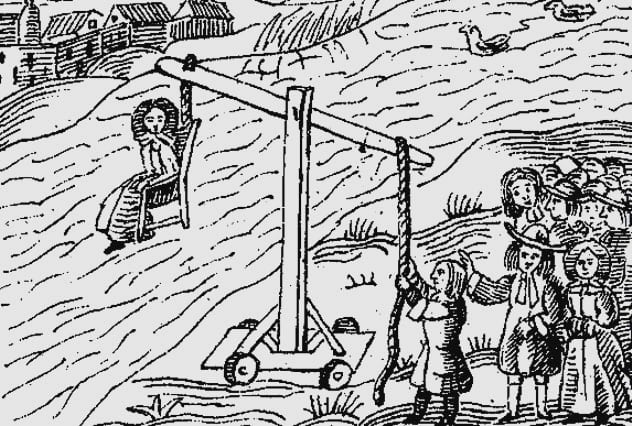
Often referred to as “dunking,” the ducking stool was the most widespread and trusted method for testing a witch. The suspect was tied to a chair or with her wrists bound to her ankles. Then she was attached to a pulley and lowered into a body of freezing water.
The logic was simple. If she was guilty, she would float on the top and be put to death as a witch. If she was innocent, she would sink to the bottom and drown.
Witch catchers believed this would work for different reasons. Some thought that witches would automatically float to the top of the water because they had renounced their baptisms as a rejection of God. Others believed that witches were able to use their magical powers to float to the top and stop themselves from drowning.
Either way, it was generally accepted that the victim was innocent and would be accepted into Heaven if she drowned and died. In the eyes of the witch catchers, this was a far better fate than living as a guilty witch bound for execution and hell. Sometimes, a floating witch would be dunked repeatedly until she confessed, which was a medieval form of water torture.[6]
Interestingly, the ducking stool was designed specifically for women only and was also used as a punishment for being a prostitute or scold. A scold was a woman who was generally considered a nuisance, who spread chaos among her neighbors by habitually chastising, quarreling, or gossiping.
In these cases, the ducking stool contraption was sometimes attached to wheels and paraded through the town on the way to the dunking site. This was to ensure maximum humiliation for the accused.
4 Weighing The Witch
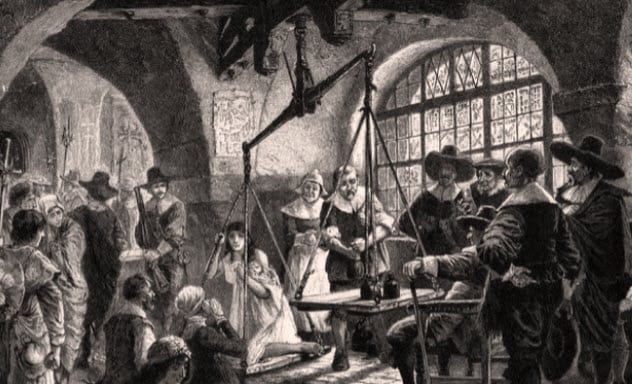
Holland had a very famous weighing house in Oudewater. Women from as far away as Germany and Hungary would travel there to prove their innocence. The idea was simple. Souls are heavy burdens to bear. As a witch would not possess one, she would be significantly lighter than an innocent woman.
The weighing house had a large set of scales. The accused would stand on one side, and cast-iron weights would be placed on the other. Women of the proper weight were given certificates to prove their innocence.[7]
The Dutch were not the only ones who believed that you could find a witch by weighing her. In Aylesbury, England, it was common practice to strip a woman naked and weigh her against a heavy, iron-bound Bible. If the scales did not balance out exactly, the woman would be convicted as a witch.
In other places in Europe, women would be weighed against stacks of Bibles. If they were not found guilty straightaway, extra Bibles were sometimes added to the pile.
3 Cruentation
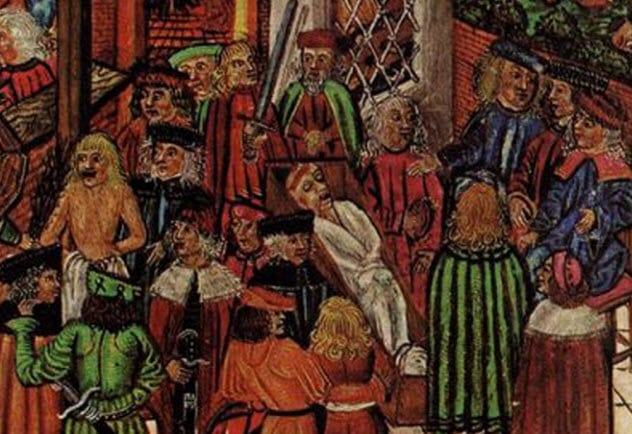
If someone was accused of murder by witchcraft, they could be proved guilty by cruentation in many European courts. They believed that the soul still resided in the body shortly after death and that the body would react unusually in the presence of the murderer.
The accused was made to call out the name of the dead person, walk around the corpse, and touch the body’s sores. If fresh blood appeared, the body moved, or it began to foam at the mouth, the suspect would be considered guilty.
What the court was actually witnessing was the leaking of a liquid known as purge fluid. It looks a lot like blood and is expelled from various orifices during putrefaction. Dead bodies may also twitch slightly, expel the contents of their bowels, or even seem to “groan” soon after death. This would be seen as the person’s soul leaving the body to further escape his killer (too little, too late).[8]
2 Have Your Witch’s Teat Discovered
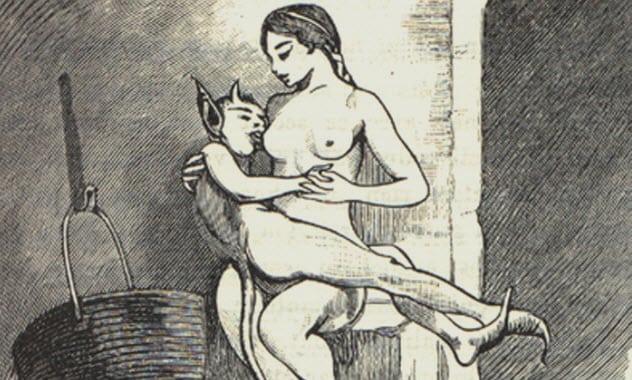
If you had a pet, it was likely that a witch catcher would try to prove your guilt by seeking out your witch’s teat. It was believed that witches kept demons in their houses as pets, disguised as dogs, cats, insects, or rodents and that these familiars suckled on a special nipple gifted to the witch by the Devil.
The presence of a mole, skin tag, or unusual birthmark on the body was considered proof that the accused was practicing witchcraft and feeding her familiar in this manner.
At least 80 percent of the people prosecuted for witchcraft were female, and the idea of a Devil-made and villainous breast is a perfect example of how misogynistic the trials really were. Many breasts of the accused were subject to brutal and humiliating treatment and were often publicly exposed or even whipped.[9]
Anna Pappenheimer from Bavaria was tortured into admitting to having sexual relations with the Devil. As punishment, her breasts were cut off and forced into her mouth and then into the mouths of her two adult sons before all three were burned at the stake.
1 Be Unable To Cry

The Malleus Maleficarum (“The Hammer of Witches”) was a medieval document published about witches, their practices, and methods to conduct trials and punish them. It was written in Latin by two German monks. For hundreds of years, it was the best-selling book in Europe, second only to the Bible.
Malleus Maleficarum stated that witches would be unable to shed real tears when put in front of a judge or even when subjected to torture. It implored witch catchers to be wary of mischievous witches who were likely to fake tears by spitting on their own faces.[10]
During the medieval period, a lack of health care and personal hygiene meant that it was common for the elderly to suffer from what we now call lacrimal ducts. This is an infection in the tear ducts that stops the sufferer from being able to shed tears. This meant that many elderly women were executed as witches simply for having poor eyes.
Fennella is a Green Witch living in London. Blog: www.fennellathewitch.com. Instagram: @fennellathewitch
Read more fascinating facts about witch hunters on 10 Absurd Facts About History’s First Official Witch-Hunter and 10 Infamous Witch-Hunters From History.








